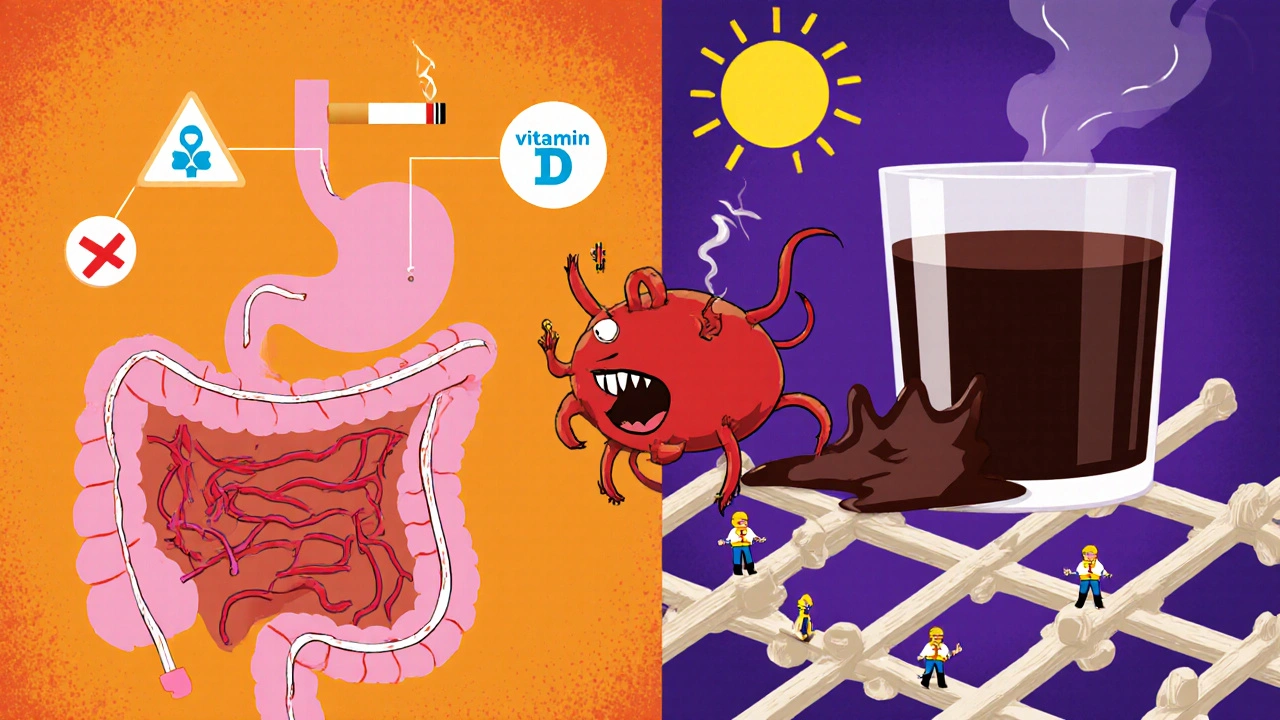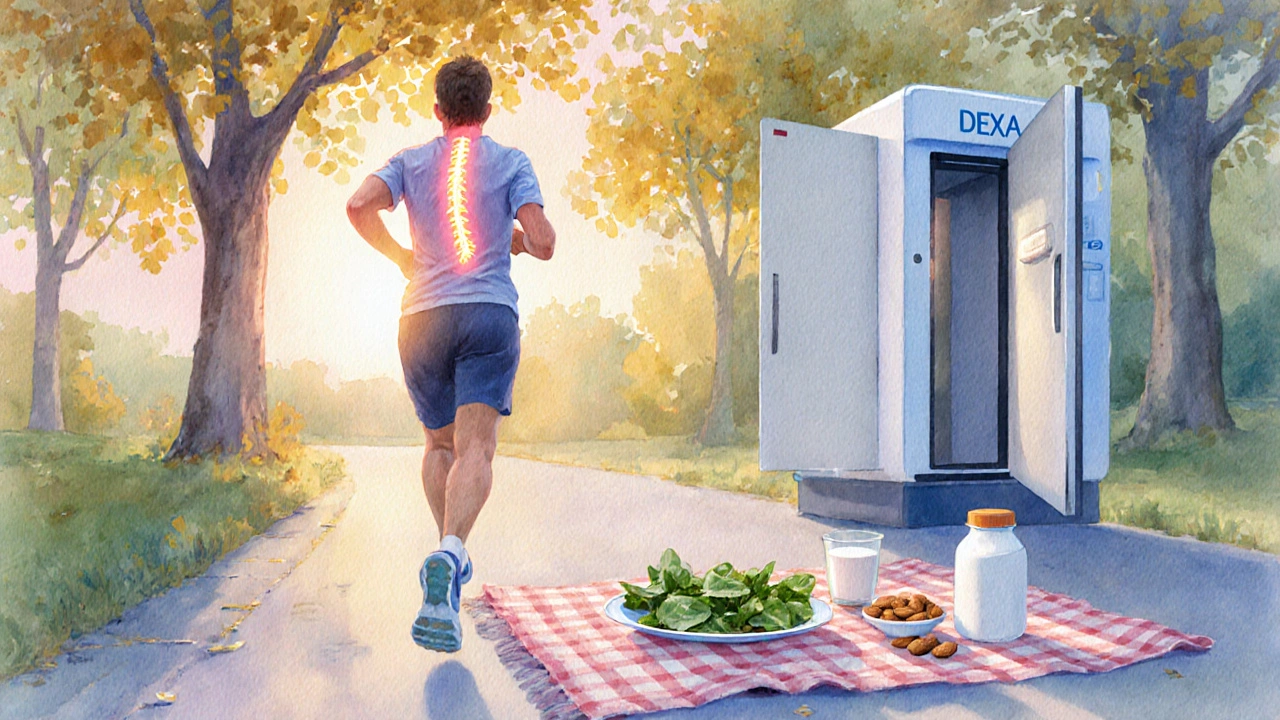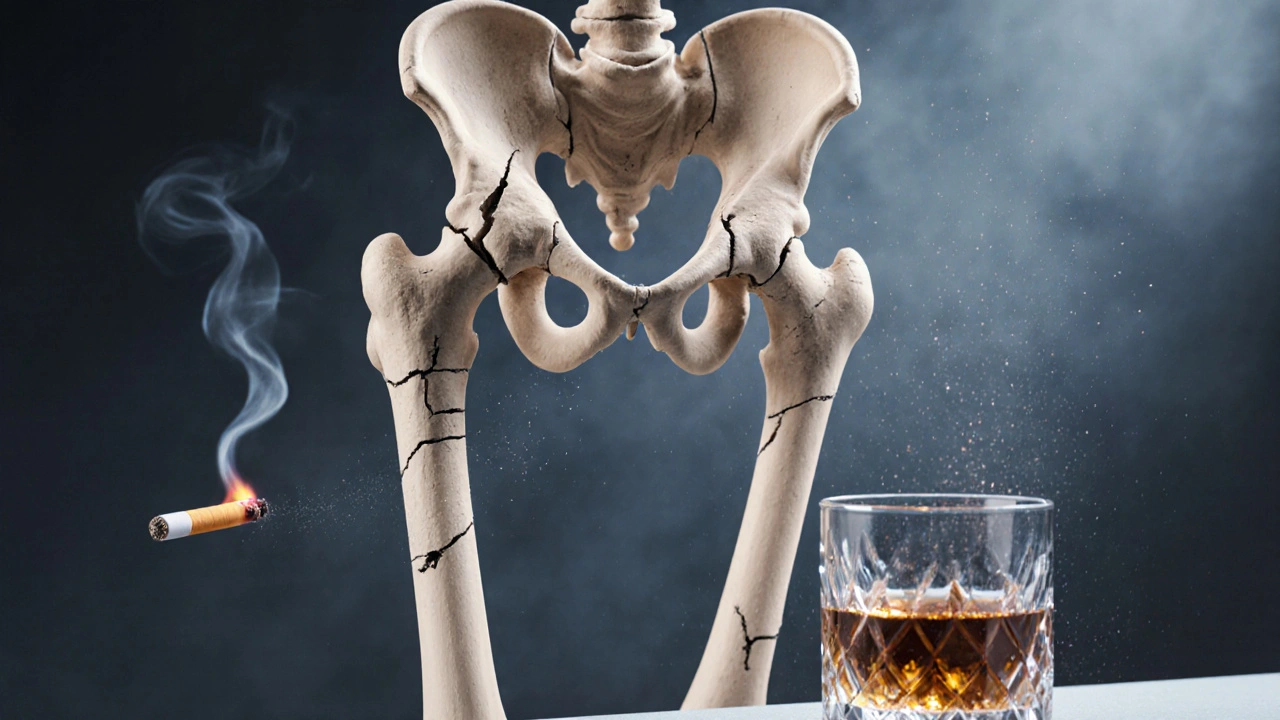Osteoporosis Risk Calculator
This calculator estimates your relative risk of developing osteoporosis before age 60 based on your smoking and alcohol habits. Enter your information below:
When you hear the words osteoporosis risk, you probably picture a brittle skeleton and scary fractures. Two everyday habits-lighting up a cigarette and sipping a drink-can push that risk much higher than most people realize. This article breaks down how smoking and alcohol mess with your bones, shows the numbers behind the danger, and gives practical steps to keep your skeleton strong.
What osteoporosis really is
Osteoporosis is a skeletal disease characterized by low bone mass and structural deterioration, leading to increased fragility and fracture risk. It isn’t just an older‑person problem; lifestyle choices in your 30s and 40s set the stage for bone health decades later.
How smoking attacks bone
Smoking is a major source of nicotine, carbon monoxide, and oxidative chemicals that interfere with bone remodeling. The damage happens on several fronts:
- Reduced calcium absorption: Nicotine narrows blood vessels in the gut, cutting the amount of calcium that reaches the bloodstream.
- Hormonal disruption: Smoking lowers estrogen in women and testosterone in men, both hormones that protect bone density.
- Increased bone resorption: Chemicals stimulate osteoclast activity, the cells that break down bone.
Evidence from the World Health Organization’s 2023 Global Bone Health Report shows that smokers lose bone mineral density (BMD) about 1-2% faster than non‑smokers. A 20‑year longitudinal study of 12,000 adults found that each pack‑year of smoking raised the odds of a hip fracture by roughly 3%.
Alcohol’s silent sabotage
Alcohol consumption can be a double‑edged sword for bone health. Moderate drinking (up to one drink per day for women, two for men) may slightly raise estrogen levels, but higher intake flips the script:
- Impaired osteoblast function: Heavy alcohol limits the cells that build new bone, slowing formation.
- Vitamin D deficiency: Alcohol interferes with the liver’s conversion of vitamin D to its active form, reducing calcium absorption.
- Falls and injuries: Excessive drinking increases the chance of accidents that lead to fractures.
The 2022 International Osteoporosis Foundation meta‑analysis pooled 30 studies and reported that drinking more than three drinks a day boosts hip fracture risk by 45% compared with abstainers.

Putting the numbers together
Both habits don’t just add risk-they amplify each other. A combined‑exposure cohort from the U.S. Nurses’ Health Study showed that women who smoked ≥10 cigarettes per day and drank ≥2 drinks daily faced a 2.5‑fold higher odds of developing osteoporosis before age 60 than those who did neither.
| Exposure | Risk Increase | Key Mechanism |
|---|---|---|
| Non‑smoker, non‑drinker | Baseline (1×) | Normal bone turnover |
| Smoking ≥10 pack‑years | 1.4× | Reduced calcium, hormonal loss |
| Alcohol >3 drinks/week | 1.3× | Impaired osteoblasts, vitamin D drop |
| Both smoking ≥10 pack‑years & alcohol >3 drinks/week | 2.5× | Synergistic bone resorption |
Other bone‑related players
While smoking and alcohol dominate the lifestyle discussion, a few other entities shape bone health:
- Bone mineral density (BMD) measures the amount of mineral matter per cubic centimeter of bone, serving as the gold standard for osteoporosis diagnosis.
- Calcium provides the structural framework; adults need about 1,000mg daily.
- Vitamin D enables calcium absorption; deficiency (<20ng/mL) triples fracture odds.
- Estrogen preserves bone by inhibiting osteoclasts; post‑menopausal drop accelerates loss.
- Fracture risk combines BMD, age, gender, and lifestyle into tools like FRAX, predicting 10‑year probability of major osteoporotic fracture.
Practical steps to lower your risk
Knowing the damage is half the battle. Here’s a checklist you can start using today:
- Quit smoking: Even cutting back to 5 cigarettes a day reduces BMD loss by about 30% within a year.
- Limit alcohol: Aim for ≤1 drink per day for women, ≤2 for men; consider alcohol‑free days each week.
- Boost calcium and vitaminD: Dairy, leafy greens, fortified plant milks, and safe sun exposure or supplements (800-1,000IU vitaminD daily).
- Weight‑bearing exercise: Walking, jogging, resistance training stimulate osteoblasts and improve balance.
- Screen regularly: Talk to your doctor about a DEXA scan if you’re over 50, have a family history, or have long‑term smoking/alcohol exposure.

How to assess your personal fracture probability
The FRAX tool combines age, sex, BMD, smoking status, alcohol intake, prior fractures, and other clinical factors to estimate a 10‑year fracture risk. Input your details on the public FRAX website (no fee) and use the results to discuss preventive medication-like bisphosphonates-with your healthcare provider.
Key takeaways
- Smoking speeds bone loss by 1-2% per year and raises hip‑fracture odds by roughly 3% per pack‑year.
- Heavy alcohol (>3 drinks/day) lifts fracture risk by about 45% and hampers vitaminD activation.
- Combined, the two habits can more than double osteoporosis risk before age 60.
- Quitting smoking and moderating alcohol, plus adequate calcium, vitaminD, and weight‑bearing exercise, can reverse much of the damage.
- Use FRAX or a DEXA scan to get a clear picture of your bone health and guide treatment decisions.
Frequently Asked Questions
Can occasional smoking still harm my bones?
Yes. Even a few cigarettes a day can reduce calcium absorption and slightly increase fracture risk. The more consistently you smoke, the faster bone density declines.
Is there a safe amount of alcohol for bone health?
Moderate drinking-up to one drink daily for women and two for men-doesn’t appear to raise osteoporosis risk significantly. Exceeding those limits begins to impair bone formation and increases fall chances.
How quickly can my bones recover after I quit smoking?
Bone turnover improves within months. Studies show a 5% BMD gain after 12months of cessation, especially when paired with calcium, vitaminD, and exercise.
Do I need a DEXA scan if I’ve never smoked or drank heavily?
If you’re under 50, have no family history, and lead a healthy lifestyle, routine screening may not be necessary. However, a baseline DEXA can establish a reference point for future monitoring.
Can supplements replace lifestyle changes?
Supplements help fill gaps, but they can’t undo the bone‑damaging effects of smoking or excess alcohol. Combining nutrition with quitting, moderation, and exercise yields the best results.


Millsaps Mcquiston
October 10, 2025 AT 23:20Smoking steals calcium from your bones, making them fragile. Alcohol adds extra stress by blocking vitamin D conversion. Cutting both habits will give you a stronger skeleton.
michael klinger
October 14, 2025 AT 05:07The tobacco lobby quietly funds studies that hide the true impact on bone density, and the alcohol industry spreads the myth of a “healthy” drink. Their hidden agenda keeps us hooked while our skeletons suffer.
Marsha Saminathan
October 17, 2025 AT 10:54If you think a few cigarettes won’t hurt your bones, think again. Every puff introduces nicotine that narrows blood vessels in your gut. That means less calcium gets into your bloodstream. Less calcium equals weaker bone remodeling. At the same time, smoking drags down estrogen in women and testosterone in men. Those hormones are the natural protectors of bone density. When they dip, osteoclasts go wild and start chewing away at the skeleton. Now add a steady flow of alcohol beyond three drinks a day. Alcohol messes with the liver’s ability to activate vitamin D. Without active vitamin D, calcium absorption stalls even more. Heavy drinking also kills off osteoblasts, the cells that build new bone. The combined effect is not just additive, it’s synergistic. Studies show a 2.5‑fold higher odds of osteoporosis when both habits are present. Your risk doesn’t just climb, it rockets. Quit smoking and cut back on booze, and you’ll see bone turnover improve within months. Your skeleton will thank you with stronger, denser bones.
Justin Park
October 20, 2025 AT 16:40Indeed, the physiological pathways you outlined align with current endocrinological models, and the data from longitudinal cohorts reinforce the synergistic risk 📊. Mitigating these behaviors should be a priority in preventive medicine 🦴.
Herman Rochelle
October 23, 2025 AT 22:27Cutting back on cigarettes and limiting drinks is a solid step toward stronger bones.
Stanley Platt
October 27, 2025 AT 04:14While the literature unequivocally demonstrates that nicotine impairs calcium absorption, and excessive ethanol disrupts vitamin‑D metabolism, it is incumbent upon healthcare professionals to integrate behavioral counseling, nutrition optimization, and weight‑bearing exercise into comprehensive osteoporosis prevention strategies, thereby addressing both modifiable risk factors and underlying physiological mechanisms,
Alice Settineri
October 30, 2025 AT 10:00Oh, come on! You think a simple “cut back” tip is enough? Your bones are screaming for a full‑blown lifestyle overhaul, not just a whisper of advice.
Dustin Hardage
November 2, 2025 AT 15:47Evidence indicates that each pack‑year raises fracture odds by roughly three percent, while consuming more than three drinks per week adds an additional thirty‑one percent risk; therefore, clinicians should advise patients to aim for zero smoking and moderate alcohol consumption to keep bone mineral density within healthy limits.
Dawson Turcott
November 5, 2025 AT 21:34Wow, thanks for the math lesson 🙄, I’ll just quit everything tomorrow, no big deal lol.
Alex Jhonson
November 9, 2025 AT 03:20Trying to keep your bones in shape? Reduce those smokes and drinks, and remember calcium and sunshine are your friends.
Katheryn Cochrane
November 12, 2025 AT 09:07Your oversimplified advice ignores socioeconomic barriers, the reality of addiction, and the nuanced interplay of genetics; a blanket statement like “just reduce” does a disservice to patients struggling with dependency.
Michael Coakley
November 15, 2025 AT 14:54Philosophically speaking, bone loss is just the universe reminding us that everything decays, especially when we invite toxins in.
ADETUNJI ADEPOJU
November 18, 2025 AT 20:40From a pathophysiological perspective, the osteoclastic overactivity induced by nicotine and ethanol can be conceptualized as a cascade of cytokine-mediated resorption, a phenomenon that, while seemingly poetic, underscores the mechanistic inevitability of degradation.
Janae Johnson
November 22, 2025 AT 02:27Contrary to popular belief, moderate alcohol consumption has been shown in some cohorts to exert a protective effect on bone density, suggesting that blanket condemnations may be overly simplistic.
Kayla Charles
November 25, 2025 AT 08:14While I appreciate the nuance you bring, the data on moderate drinking is far from conclusive. Many of those studies suffer from selection bias and fail to control for physical activity. Moreover, the definition of “moderate” varies wildly across cultures. What one country deems moderate might be excessive elsewhere. When you factor in the additive risk of occasional smoking, the protective signal evaporates. Thus, recommending any level of alcohol without considering the full lifestyle picture can be misleading. A holistic approach that prioritizes bone‑strengthening nutrition and regular weight‑bearing exercise remains the most reliable strategy. In short, err on the side of caution and keep both habits in check.